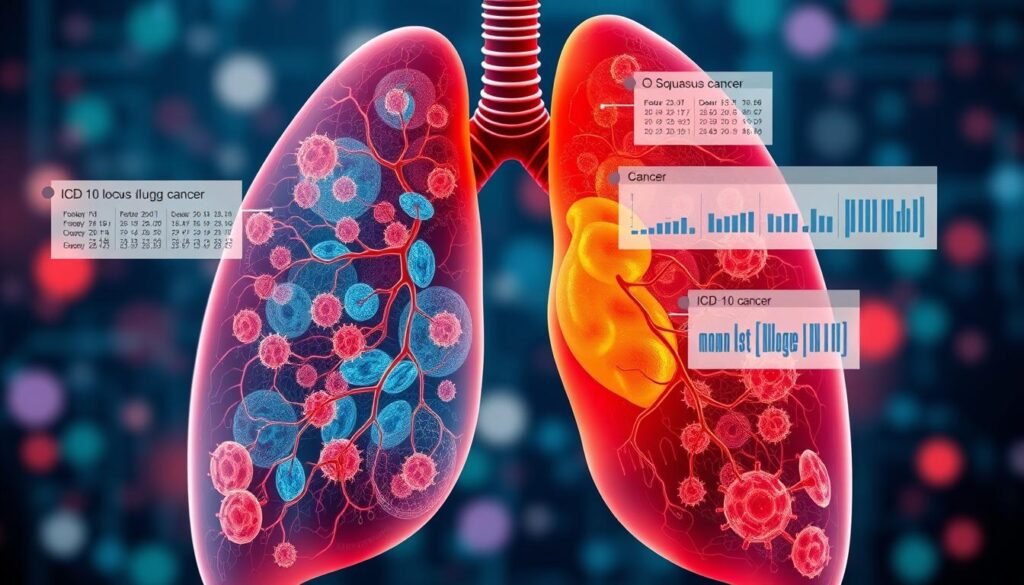Lung cancer leads in cancer deaths, with over 150,000 people dying each year in the US. Squamous cell carcinoma, a common lung cancer type, makes diagnosis and treatment hard. Knowing the ICD 10 code for squamous cell lung cancer is key for medical documentation and care.
This guide explains the ICD 10 codes for lung cancer. It shows why correct coding is so important for patient care. Good coding helps get better data and manage lung cancer treatment well. It covers squamous cell lung cancer’s details and how to document it right. For more on its histology and diagnosis, check this helpful resource.
Lung cancer is a major health issue, and we must be aware of how to classify and treat it. Now, let’s look at lung cancer details.
Key Takeaways
- Lung cancer is a leading cause of cancer deaths, affecting thousands annually.
- Squamous cell carcinoma is a major subtype of non-small cell lung cancer.
- Understanding ICD 10 codes is vital for accurate medical documentation.
- Proper coding contributes significantly to effective care plans for lung cancer patients.
- Stay updated on coding changes to ensure compliance and optimal patient care.
Introduction to Lung Cancer
Lung cancer is now a major health issue in the United States, affecting millions. Knowing the types of lung cancer is vital for proper diagnosis and treatment. There are two main kinds: small cell lung cancer and non-small cell lung cancer. The latter is further broken into subtypes, like squamous cell carcinoma, often related to smoking and carcinogens.
Recent statistics show lung cancer is a big health challenge. It highlights the urgent need for awareness of lung cancer risks. Smoking, secondhand smoke, and pollution increase cancer risk. Understanding these risk factors plays a pivotal role in prevention efforts.
The more people know about lung cancer, the better. Education on early signs, treatments, and how to manage the disease is crucial. This not only helps patients but also strengthens the support from networks and healthcare systems in combatting lung cancer.
Understanding Squamous Cell Lung Cancer
Squamous cell carcinoma is a major type of lung cancer. It starts in the cells lining the lungs. This cancer varies in how aggressive it is and in its microscopic features. Therefore, it’s vital for doctors to understand it well. This helps them create the best treatment plans.
People who smoke for a long time, come into contact with harmful substances like radon and asbestos, or have had lung diseases can get this cancer.
The ICD-10 codes place this cancer in category C34. This includes cancers of the lung and bronchus. Knowing these codes helps with studies and research. This, in turn, improves how patients are cared for.
As we learn more about public health, we get better at preventing squamous cell lung cancer. Knowing the risks helps. Knowing how this cancer is different helps doctors treat it better. They can make care more personal and targeted.
Importance of Accurate Coding in Lung Cancer Care
Accurate medical coding is essential in lung cancer treatment. It ensures patients receive complete care. Mistakes in coding can cause treatment delays. They can also impact the whole care process. Good documentation allows doctors to plan and apply the right strategies. It also keeps billing errors low.
Precise coding does more than help patients right away; it affects insurance payments too. The ICD-10-CM system has around 68,000 codes for diagnoses. It lets doctors describe patient problems, other health issues, and treatment choices in detail. This helps coordinate care better and understand lung cancer more deeply.
Many things can make coding less accurate. This includes who the patient is, details about their disease, and the healthcare system. Older patients, especially those over 80, might not be assessed as well by coding algorithms. This shows how important it is to pay close attention to their needs. Sometimes Medicare data is less accurate because it lacks information. This might include key data on cancer stage or whether it affects one or both sides of the body.
Doctors should record everything about a lung cancer patient’s condition. This includes whether they smoke or have had treatments before. These details help create better care plans and judge patient risk. Mistakes in coding or missing records can hide important patient history. This makes it hard to follow healthcare results.
Good coding matters for billing and lays the groundwork for future payment systems based on care quality. Coding should fully reflect every patient’s treatment for lung cancer. Being precise helps show the full story of treatment, which is key for improving care quality.
| Factor | Impact on Coding Accuracy |
|---|---|
| Patient Age | Lower sensitivity in older patients |
| Prior Treatments | Need for detailed documentation to inform care |
| Insurance Coverage | Affects reimbursement and care strategies |
| Data Completeness | Missing SEER data leads to inaccuracies |
Being accurate in billing and coding fights lung cancer better. A planned approach leads to better patient results. It also makes their experience with care better. As coding updates continue, it’s important for doctors to keep learning. This way, they can best help their patients.

ICD 10 Code for Squamous Cell Lung Cancer
Squamous cell lung cancer coding involves many specific codes. They highlight key aspects of the condition. C34.1 is one important code. It means malignant neoplasm of the upper lobe, bronchus, or lung. This code is vital for precise ICD 10 coding. It helps healthcare workers clearly state the patient’s diagnosis.
Specific Codes and Their Significance
It’s crucial to know the codes for squamous cell lung cancer. This knowledge aids in planning the right treatment. Take C78.00 for example. It points to a secondary malignant neoplasm of an unspecified lung. Starting October 1, 2024, it will help in reimbursement processes. Each ICD 10 coding choice mirrors the type and location of the lung cancer. This affects surgery and treatment plans.
How to Document the Condition Properly
Following the right documentation rules is key in lung cancer coding. Medical records must clearly show the healthcare provider’s diagnosis. This includes details like where the cancer is located. Codes like Z85.118 are used to note a personal history of bronchus and lung cancer. These codes are important for tracking a patient’s health history. Keeping records up to date helps with compliance. It also ensures all important details are easy to find for coding practices. This leads to better care for patients.

Symptoms and Signs of Lung Cancer
Lung cancer symptoms vary with the disease stage. Finding them early is key for a good lung cancer diagnosis. Knowing these signs helps identify the cancer type, like the common squamous cell lung cancer.
Lung Cancer End of Life Symptoms
As lung cancer gets worse, end of life symptoms appear. These include:
- Persistent coughing
- Wheezing
- Chest pain or discomfort
- Severe fatigue
- Weight loss
- Difficulty swallowing
- Shortness of breath
These late-stage symptoms need good management. It helps improve life quality, particularly with hospice care. Knowing them helps provide the right support in tough times.
Terminal Lung Cancer Signs and End-Stage Indicators
In lung cancer’s final stages, patients show certain critical signs. These signs are:
- Shortness of breath or increased respiratory distress
- Confusion or changes in mental status
- Inability to perform basic daily activities
- Development of frequent infections
Recognizing these signs is crucial for offering the right care. It ensures comfort and dignity at life’s end. Managing end of life symptoms early can greatly improve patient comfort during these moments.
Palliative Care and Management Options
Palliative care is crucial in treating lung cancer effectively. It aims to ease symptoms and improve life quality for patients. A complete palliative care approach includes pain management, emotional support, and help with daily tasks. This broad strategy makes sure patients get symptom management and explore treatment choices.
Palliative Care for Lung Cancer
Palliative treatments are a must for those with advanced lung cancer. Care teams work with oncologists to create personalized plans. These plans tackle both the physical and emotional issues patients face. Such efforts feature:
- Medication for pain relief
- Counseling services for emotional distress
- Nutritional guidance aimed at improving well-being
These strategies enhance effective symptom management and highlight the need for inclusive lung cancer management.
Managing Lung Cancer Symptoms Effectively
Managing lung cancer symptoms effectively includes drugs and holistic methods. The mix of strategies can feature:
- Physical therapy to promote mobility
- Relaxation techniques for stress reduction
- Nutritional support to maintain strength
This broad plan helps decrease symptoms, keeping patients comfortable and respected. Recognizing that managing symptoms is a constant effort helps patients and families make better choices about lung cancer care. For more info on the value of palliative care coding and consultation, see this study.

Emotional and Psychological Support for Patients
The journey through lung cancer can be very hard. Emotional support is crucial for those fighting lung cancer. It helps them deal with feelings like anxiety, sadness, and fear. Providing psychological care along with medical treatment helps a lot. It makes them stronger in facing this tough time.
Emotional Support for Lung Cancer Patients
Having a good support system is important. It helps patients as they go through their treatment. They get comfort from talking to professionals and joining groups with people like them. This kind of support helps them find ways to deal with their situation. They learn from others and feel less alone. This helps them stay strong and positive.
Quality of Life in End-Stage Lung Cancer
Quality of life is very important for those with serious cancer. Doctors try to make sure these patients stay as comfortable as possible. They focus on keeping their dignity and making them feel okay emotionally. They check on the patients often to see if their needs change. This way, they make sure the patients get the right support at the end of their life. It helps them stay peaceful and keep their dignity during these tough times.
| Support Resources | Purpose | Benefits |
|---|---|---|
| Professional Counseling | Address mental health needs | Improves coping mechanisms, reduces anxiety |
| Support Groups | Facilitate peer interaction | Creates a sense of community, enhances emotional well-being |
| Educational Materials | Inform patients about their diagnosis | Empowers decision-making, decreases uncertainty |
Conclusion
Knowing how to code for squamous cell lung cancer is key in better patient care. The C34 code is vital for identifying, treating, and keeping track of this common disease. When healthcare workers use correct coding, patient treatment gets better.
Lung cancer awareness also plays a huge role. It helps both patients and medical teams understand the disease better. This guide aims to help everyone face lung cancer’s challenges. Care also includes emotional and psychological support, which is important for patients.
Finally, good patient care relies on correct coding, education, and support. With the right knowledge and actions, we can improve how we manage lung cancer. To learn more about coding and patient care, please visit this link.